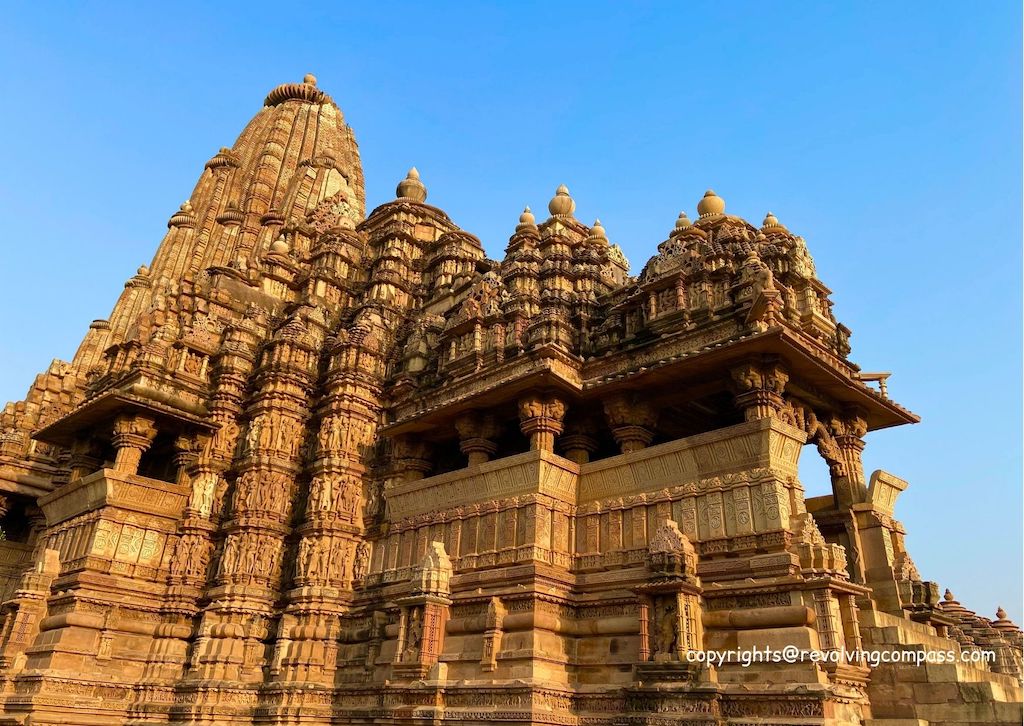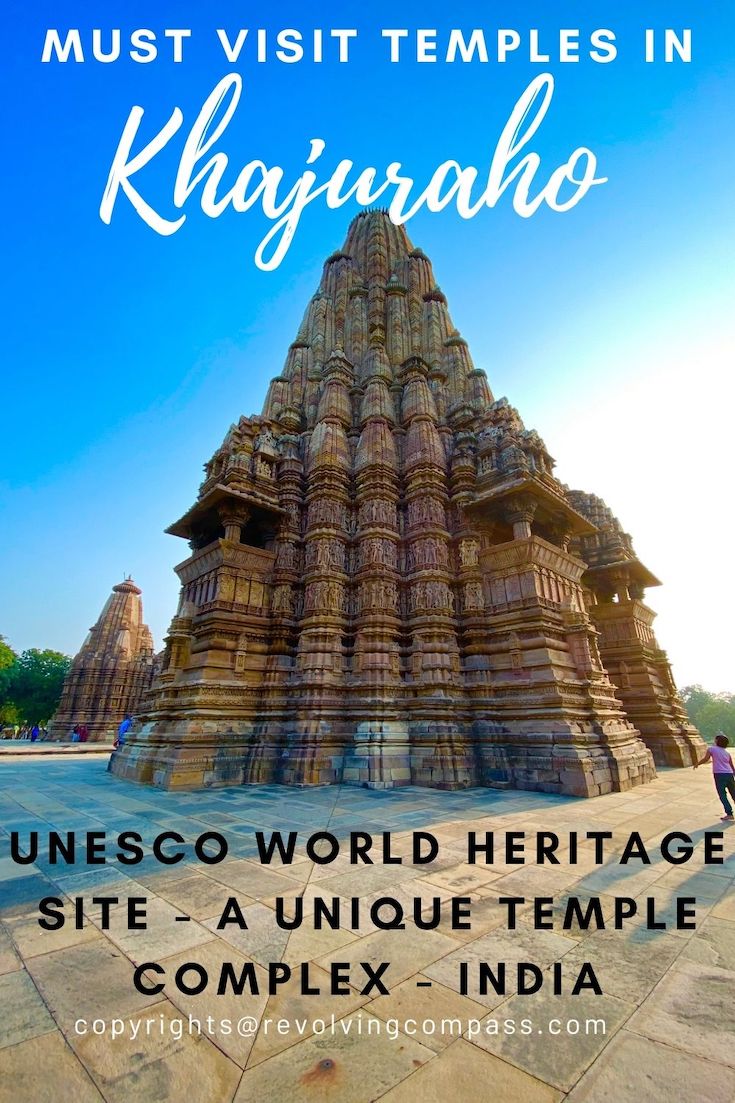
The temples of Khajuraho , UNESCO World Heritage site, and epitome of temple architecture of medieval India, are world famous. They don’t need any introduction. We all have at some point, heard about these temples. And we all know a bit about these. At least thats what I thought. Until our recent road trip to MP. When we reached Khajuraho after exploring Bhedaghat and Jabalpur, and doing a tiger safari in Bandhavgarh. We arrived at our hotel in Khajuraho, the Clarks Khajuraho, by 2:00pm. And after a swift check-in and lunch, we set out to explore the Khajuraho Temple Complex.
That is when, on our way, we met a guide. Who explained to us about the multiple temple complexes of Khajuraho. Which, obviously, we were unaware of. And also took us to visit some of the most significant, must see temples of Khajuraho. So, I am listing down these temples here for you. If you happen to visit the temples of Khajuraho, you will know which ones not to miss . And if you want to know how exactly to visit these temples and what itinerary to follow, you can refer to our complete guide on visiting the temples of Khajuraho.
Khajuraho temple complex
The small town of Khajuraho was once home to 80+ temples. And these were divided into 3 major complexes :-
Western group of temples
Eastern group of temples
Southern group of temples
Many of these temples are ruined now, after centuries of invasion, restorations and changes. As of now, there are a total of less than 40 temples still standing the test of time. Although, the Western Temple Complex is the main one. Where a lot of important and exceptionally beautiful temples lie within an enclosed campus. And if you simply put “Khajuraho Temple Complex” in google maps, it will point you to the Western Temple Complex of Khajuraho. Also, when pressed by time, visitors often just visit the Western Temple Complex of Khajuraho. But, the Eastern Temple Complex and Southern Temple Complex of Khajuraho also contain some very significant temples. So, if you have time, surely don’t miss these out. Having said that, let’s take an armchair tour of the main temples in each of these temple complexes.
Western group of temples Khajuraho
Varaha Temple

As you enter the western temple complex of Khajuraho and take a left, the Varaha Temple is the first temple you see. This is a temple dedicated to the “Varaha Avatar” of God Vishnu, the incarnation that he had taken to save the earth from a demon.
Lakshmana Temple

Right opposite to Varaha Temple lies Lakhsmana Temple. This temple is also dedicated to the “Vaikunth” form of God Vishnu. And it one of the very few temples of Khajuraho that has not suffered any damage. This temple has one of the most elaborate complexes. With very intricate carvings, this is one of the most beautiful temples in the Western Temple Complex of Khajuraho. This temple faces east. And the first rays of the rising sun adorn the idol inside the temple. This temple was built by the Chandela Ruler Yashovarman in 930-950 CE.It is a sandhara temple of the Panchyatna variety.
This temple consists of all the elements of a well developed temple – the maha mandapa with transepts, antarala and garbh-griha which is enclosed by an inner ambulatory. The wall portion of this temple is decorated with balconied windows. And the walls of the temple consist of graceful sculptures including divine figures, couples and erotic scenes. Some other major sitings in the temple sculptures include saptsakha, Goddess Lakshmi, Gods Shiva and Bhrahma, navgraha, 3 headed and 4 armed image of Vishu, and animals like bore and lion.
Kandariya Mahadev Temple

The Kandariya Mahadev Temple lies towards the rear of the Western group of temples. You can take the path besides the Lakshmana Temple to reach this temple. Again, it is one of the most intricately carved temples of Khajuraho group of temples. It’s carvings and architecture represent the epitome of the architectural merit during this era. This is one of the temples which has almost 10% erotic sculptures. While the rest of the carvings show the daily lives of the people, the women doing makeup, warriors, hunters, musicians, dancers, animals like elephants, horses, and even some mythological creatures.
The temple has a 5 layer of ceiling or mandapas, leading to the central one, in gradual ascent. Also, the temple consists of the mukha-mandapa, antarala and garbha-griha. It is the largest and the most extensively designed temple in the Khajuraho group of temples. In fact, it is the loftiest and the largest of the temples of Khajuraho. Also, this is the only amongst the temples of Khajuraho that has 2 makar torans, both of exquisite design.
Parvati Temple

Parvati Temple lies behind the Vishwanath temple, which is in front of the Khajuraho Temple complex. It can be visited along with Vishwanath Temple, when one returns from the rear side of the complex, making a full circle of the grounds. As the name suggests, this temple is dedicated to Goddess Parvati. It is a smaller and simpler temple when compared to other temples in the complex. In fact, some consider it to be part of the Vishvanath Temple. However, originally this temple also consisted of a garbh-grih, antarala and mukha-mandapa. Presently plinth of the sanctum and antarala has survived but the mukha-mandapa is completely lost. The temple has a beautiful image of Goddess Uma inside.
Bull Temple

Right in front of the Vishwanath Temple lies a bull temple. It is dedicated to bull, the animal used by Lord Shiva for his transport.
Chitragupta Temple

Dedicated to God Chitragupta, this temple lies towards the right rear of the western group of temples in Khajuraho. The architecture of this temple is very similar to that of Kandariya Mahadev Temple and Lakshamana Temple, but it is much smaller in it’s overall size.
Jagdambi Temple

The Jagdambi Temple is the only temple that shares it’s platform with the Kandariya Mahadev Temple. It is dedicated to the wife of Lord Shiva, Parvati. However, the idol is black which indicates it’s resemblance to other form of Devi Parvati – Kali. So, this temple is also called the Kali Temple. It’s grandeur is next best to the Kandariya Mahadev Temple in the western group of temples of Khajuraho.
Vishwanath Temple

The Vishwanath temple lies towards the right side of the entrance to the Western Temple Complex of Khajuraho, parallel to the Lakshmana Temple. It is one of the largest temples in the Khajuraho Group of temples. Actually, amongst the temples of Khajuraho, the Vishvanath temple is the finest and best preserved example of Chandella architecture. The temple consists of a mukha-mandapa (entrance porch), maha mandapa with transepts, antarala and garbh-grih enclosed by an inner ambulatory with transepts on the sides and rear. Architecturally, this temple falls between the Lakshmana Temple and the Kandariya Mahadev Temple. The mandapa inscriptions refer to the dedications of two lingas in this temple, one made of emerald and the other of stone. But only the stone linga survives as of today.
Eastern group of temples of Khajuraho
Javari Temple

The Javari temple was built between 1075 – 1100 C E. It’s architecture is very similar to some other temples in the eastern group of temples like the Vamana Temple. Actually, it has a very well proportionate architecture that consists of a sanctum, vestibule, mandapa and portico. But, it doesn’t have a pradakshinapath which most of the other temples of Khajuraho have. Although it does have a very remarkable makar toran. And also a beautiful shikhar (top dome). It is decorated with three bands of very beautifully carved structures on it’s outer walls, resonating to the medieval temple architecture of India. This temple has a very close resemblance to Chaturbhuj temple in the Western Group of Temples. And, it is one of the most remarkable temples of Khajuraho.
Vamana Temple

This temple, as the name suggests, is dedicated to the Vamana Avatar of lord Vishnu. It is a nirandhara Temple. It’s plan consist of a saptratha sanctum, vestibule, maha mandapa and entrance porch. The sanctum has an idol of a 4 armed Vamana, flanked by Chakrapursha on the left and Sankhapursha on the right. Also, the sanctum entrance has seven bands decorated with stenciled scrolls, dancing ganas, mithunas, lotuspetals and wavy scrolls terminating in the figure of naga. Followed by Ganga and Yamuna standing in tribhang, flanked by female attendants on one side carrying purna-ghata, and standing door keepers on the other side.
While the lintel consists of a 4 armed Vishnu at the centre, the side niche represent Brahma and Shiva – thus completing the trinity of Gods. It is one of the most beautiful temples of Khajuraho that we visited during our trip to the eastern group of temples of Khajuraho.
Brahma Temple

I am not sure how many temples in India are really of God Brahma. But I am sure there are very less when compared to the temples of Vishnu and Shiva. This Brahma Temple in Khajuraho is definitely one of the oldest and finest. It is one of the eastern group of temples. And lies on the bank of a lake in the centre of the Khajuraho town. Another must visit temple of Khajuraho.
Adinath Temple & Parshvnath Temple
Two temples, dedicated to Jain tirthankars in Khajuraho are Adinath Temple and Parshvnath Temple. Although, these are also counted as the eastern group of temples of Khajuraho. We couldn’t visit these temples as it was already late by the time we completed visiting other temples. But, we will highly recommend that you visit these to see the Jain and Hindu blend of architecture amongst the temples of Khajuraho.
Southern Temple Complex of Khajuraho
Duladeo Temple

Dulhadev Temple is yet another temple of Shiva. It is traditionally know as “Kunwar Matha” and is notable as the latest temple of Khajuraho. It consists of a sanctum without ambulatory, vestibule, maha-mandap and an entrance porch. The shikhara of the temple is clustered around by 3 other minor shikharas around it. It’s octagonal mahamandap shows some peculiarity of design and decor. And it is also having the largest span among all the Khajuraho temples. It is notably decorated with 20 apsaras-brackets abutting against its corbelled circular ceiling. The original temple can be dated back to the early half of the 12th century C E . The temple campus is huge and very well manicured. At the time of our visit, the temple was undergoing some repair work, so you see the bamboos around the temple in the picture.
Parshvanath Temple

Actually, the first temple that we visited as we explored the southern and eastern group of temples in Khajuraho was the Parshvnath Temple. It’s a 10th century jain temple. The temple was constructed by Jain family in 950-970 C E. During the reign of Chandela king Dhanga. The entrance has an inscription with a most-perfect magic square . It is located in it’s own campus, a little further than the rest of the temples.
Conclusion
With this, we conclude our list of must visit temples of Khajuraho. We visited Khajuraho on our road trip across Madhya Pradesh. As a part of this road trip we visited Jabalpur and the Dhuandhar Waterfalls and Narmada Valley Marble Rocks of Bhedaghat, Bandhavgarh National Park, explored the temples of Khajuraho, visited the Orchha Fort and Cenotaphs, worked from Orchha, then traveled from Orchha to Bhopal via Sanchi and Udayagiri caves. And finally visited Pachmarhi, in that order. You can check the links above if you want to know the details of our MP Road trip.
PS: Some of our links are affiliated, this means we will earn a commission when you buy a service or product by clicking those links. However, this will have no extra cost for you.
 |
 |
 |